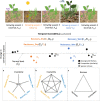Multidimensional responses of grassland stability to eutrophication
- PMID: 37821444
- PMCID: PMC10567679
- DOI: 10.1038/s41467-023-42081-0
Multidimensional responses of grassland stability to eutrophication
Abstract
Eutrophication usually impacts grassland biodiversity, community composition, and biomass production, but its impact on the stability of these community aspects is unclear. One challenge is that stability has many facets that can be tightly correlated (low dimensionality) or highly disparate (high dimensionality). Using standardized experiments in 55 grassland sites from a globally distributed experiment (NutNet), we quantify the effects of nutrient addition on five facets of stability (temporal invariability, resistance during dry and wet growing seasons, recovery after dry and wet growing seasons), measured on three community aspects (aboveground biomass, community composition, and species richness). Nutrient addition reduces the temporal invariability and resistance of species richness and community composition during dry and wet growing seasons, but does not affect those of biomass. Different stability measures are largely uncorrelated under both ambient and eutrophic conditions, indicating consistently high dimensionality. Harnessing the dimensionality of ecological stability provides insights for predicting grassland responses to global environmental change.
© 2023. Springer Nature Limited.
Conflict of interest statement
The authors declare no competing interests.
Figures




References
-
- Aichi targets. https://www.cbd.int/aichi-targets/target/8.
-
- IPCC (2019). Summary for policymakers. In P. R. Shukla, et al (Eds.), Climate change and land: An IPCC special report on climate change, deserti- fication, land degradation, sustainable land management, food secu- rity, and greenhouse gas fluxes in terrestrial ecosystems(p. 5). World Meterological Organization. 7–22 http://www.gtp89.dial.pipex.com/AR4.htm.
-
- IPBES (2019): Summary for policymakers of the global assessment report on biodiversity and ecosystem services of the Intergovernmental Science-Policy Platform on Biodiversity and Ecosystem Services. (eds Díaz, S. et al.) (56 IPBES secretariat, Bonn, Germany).
-
- MacArthur R. Fluctuations of animal populations and a measure of community stability. Ecology. 1955;36:533. doi: 10.2307/1929601. - DOI
-
- Pimm SL. The complexity and stability of ecosystems. Nature. 1984;307:321–326. doi: 10.1038/307321a0. - DOI
Publication types
MeSH terms
LinkOut - more resources
Full Text Sources

